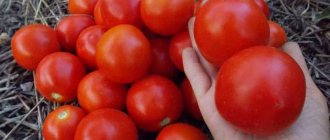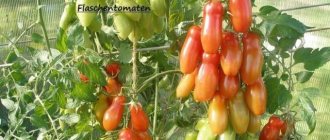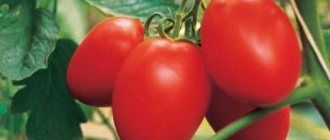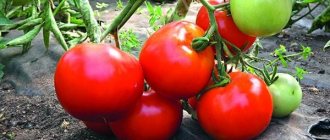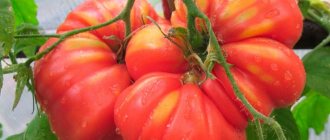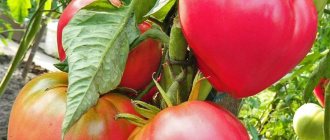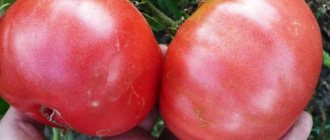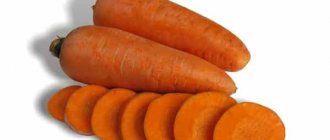Legendary varieties of tomatoes, bred by a school physics teacher, gained popularity in the last century and have not lost their relevance to this day. On the contrary, they are becoming increasingly widespread due to their reliability and simple agricultural technology.
The Jubilee Tarasenko tomato is suitable for those who want to get a rich harvest from a small plot, spending a minimum amount of time and effort. The taste of ripe vegetables will please you not only in fresh salads, but also in winter preparations.
Characteristics and description of the variety
Ukrainian physics teacher and amateur gardener F. M. Tarasenko developed more than 50 types of tomato crops. The Legend Tarasenko and Yubileiny tomatoes are especially popular. The Yubileiny Tarasenko tomato variety is much older than Legend; it has been known to gardeners for 30 years. It is based on several varieties and hybrids, one of which is the Mexican variety San Marzano.
Distinctive features
The type is indeterminate, height is 2-3 m, which is why the culture is called liana-like. The stem is powerful, the foliage is weak, the leaves are large, dark green. The inflorescences are simple, growing in the form of a cluster. The clusters are complex, each producing 20-25 fruits. The first brush is formed above the 9th leaf, subsequent ones every 2 leaves.
Mid-season species, 115-120 days pass from the moment of seedlings to full ripening. Fruiting is extended, ripe vegetables are harvested within 1.5 months.
The yield is high, up to 8 kg is harvested from 1 seedling when placing 2 plants per 1 square meter. m.
Resistance to the main diseases of the nightshade family is high. The culture is immune to late blight and brown spot.
Recommended for cultivation in open ground and in greenhouse conditions. The species is resistant to low temperatures.
Tall bushes require obligatory staking and regular pinching.
Fruit characteristics
Average weight 90-100 g, round, slightly elongated shape, red-orange color. The taste is rich, sweet and sour. The pulp is dense, fleshy, the peel is thin but durable and does not crack.
The purpose is universal; the fruits are used fresh for preparing a variety of dishes. Thanks to their durable skin, they do not crack during salting and preservation. It is used extremely rarely in processing for tomato products; due to the dense pulp, it is almost impossible to obtain juice from tomatoes.
Tomatoes can be stored for up to several months and can withstand long-term transportation.
The photo shows Yubileiny Tarasenko tomatoes.
Features of planting and growing tomato Yubileiny Tarasenko
All vine tomatoes are grown slightly differently than most similar indeterminate varieties. F. M. Tarasenko himself described in detail the agricultural technology of his varieties, the main thing in which is freedom for the bushes, a large amount of fertilizers and timely tying of the stems. Of course, Jubilee Tarasenko is grown only through seedlings; the seeds for this are sown at the usual time. Since the variety is mid-season, in most regions seedlings begin to be grown in mid-March, and for greenhouses - two weeks earlier.
It is necessary to grow seedlings of this tomato in separate pots, and not small ones
You can sow the seeds in a small box, but the seedlings should be planted immediately in large pots with a capacity of about a liter. If you save on the size of the container, a second transplant may be required closer to May: tomato seedlings of this variety grow very large, and the root system is massive. Do seedlings need fertilizing? For many varieties, they try to do without this so that the seedlings do not become pampered. Anniversary Tarasenko requires a lot of nutrients, so most likely it will not be possible to do without feeding.
Seedlings are planted at the usual time, but not in the same way as most tomatoes. For liana-like varieties, dig a whole planting hole, up to a bucket in volume. Add at least half a bucket of humus and a good handful of ash into it, mix well. At the same time, you should not bury the roots deeply; If the seedlings are very overgrown, it is better to plant them at an angle. The layout is free, but the distance between the bushes must be at least 70 cm. The construction of a trellis is mandatory: ordinary stakes are not enough. You have to tie up both the stems and each fruit cluster, and not in one place. Often, supports or even wooden boxes are placed under the brushes. Some gardeners place the main stems of the plant horizontally, tying them in several places to the wire.
To grow liana-shaped tomatoes, you need trellises made of very durable materials.
A lot of water is required for irrigation: before the fruits begin to ripen - at least a bucket per week, then watering is greatly reduced. Feeding is carried out every two weeks. The bush is led into one or two stems, the emerging stepsons are constantly broken out. Pick off the leaves as they turn yellow. The growth of the bush is limited by pinching the stems at a certain height or after four or five clusters, depending on the climate of the region.
It will still not be possible to grow all the fruits, so the stems are cut off at a certain height
In addition to removing the stepsons, it is necessary to normalize the number of flowers, removing the smallest or late ones. You can leave no more than 30 fruits in each brush. Tomatoes should not necessarily be picked when they are fully ripe: to continue bearing fruit, they are picked in a state of blanche ripeness. They ripen well during storage.
How to grow seedlings
Sowing seeds for seedlings begins 2 months before planting in the ground. Gardeners can collect seed material from their own harvest, since it is a varietal crop, which means the genetic information is preserved for years.
Seed preparation
Self-harvested grains are disinfected and prepared for sowing. Disinfection takes place in a weak solution of potassium permanganate for 20-30 minutes. Then they are washed and dried.
To improve germination, the grains are soaked in a growth stimulator for 11 hours. As a stimulant, in addition to special preparations, melt or ordinary boiled water is used.
Reference! The most commonly used growth stimulants are Epin, Kornevin and Immunocytophyte.
Container and soil
The soil is prepared from garden soil and humus in equal quantities. A little sawdust or washed river sand is added as a leavening agent. The resulting mixture is poured with a hot solution of dark potassium permanganate or steamed in the oven at 60 °C for 10 minutes. The cooled soil is laid out in planting containers, filling them halfway. This makes it possible to add soil to the containers as the seedlings grow, thereby providing additional nutrition.
You can plant them in a common wooden box or in individual containers, at the bottom of which drainage holes are first made. When planting in separate containers, further care for tomatoes is reduced to a minimum.
Reference! Drainage holes at the bottom of the planting containers do not allow moisture to stagnate, which prevents the development of diseases such as blackleg.
Sowing
Seeds are sown to a depth of 2 cm with a distance of 3 cm from each other. Sprinkle soil on top, lightly compact and cover the containers with film to create a greenhouse effect. Planting containers are left in a bright and warm room at a temperature of 24-25 °C. Periodically, the film is removed for ventilation and, as the upper soil layer dries out, it is moistened with warm, settled water using a spray bottle.
Seedling care
When shoots appear, the film is removed and the containers are moved to the windowsill. Since seedlings tend to stretch, it is necessary to provide a sufficient amount of light for a long time. During the first few days, experienced gardeners illuminate the plantings around the clock with electric fluorescent lamps.
Water with moderately warm, settled water along the edge of the containers using a shallow watering can. After watering, the soil is loosened with a wooden stick or an ordinary fork.
Reference! Loosening is carried out superficially so as not to touch the young roots.
When 2 true leaves appear, the seedlings are picked and placed in separate containers. During picking, strong and healthy plants are left for further development. After picking, the growth and development of seedlings is more intense.
Reference! When growing seedlings in peat containers, picking is not required.
Hardening begins 2 weeks before planting in the ground. To do this, the seedlings are taken out into the open air for 1 hour during the daytime. Gradually the time interval is increased to 12 hours. Simultaneously with daytime hardening, the night temperature in the room is reduced to 13 °C.
Features of cultivation
The variety is unpretentious in care, but requires proper agricultural technology, like all tall and productive tomatoes. Recommended for growing using seedlings.
Important! Jubilee Tarasenko is a variety, so you can collect seeds from grown tomatoes; they do not lose varietal qualities, unlike hybrids.
Planting time depends on the climatic conditions of the region. In central Russia, seeds are sown at the end of March. That is, by the time the seedlings are transferred to the main place, the seedlings should be 55-60 days old. For planting in a greenhouse, seeds are sown 2 weeks earlier.
Before sowing, the soil must be disinfected and the acidity adjusted - it should be low or neutral. Seeds are also disinfected in a weak solution of potassium permanganate. After which they are washed, dried a little and treated with the growth stimulator Zircon.
The seeds are buried 1.5-2 cm into the ground according to a 2x2 cm pattern. Sprinkle the top with a small layer of soil and water with warm water.
Picking is carried out when 2-3 true leaves appear on the seedlings. For this, use 250-300 ml cups, since the roots of this variety are powerful and they need space for proper development.
Advice! Jubilee Tarasenko tomato seedlings are prone to elongation. This can be prevented by illuminating the seedlings with fluorescent lamps.
Before planting in a permanent place, seedlings are hardened off for 14 days. The seedlings are taken outside for the day and brought indoors at night.
By this time, the seedlings should have 7-8 leaves, and flower ovaries may appear.
Holes with a diameter of about 15 cm are dug to a depth of 30 cm in a checkerboard pattern with an interval of 60-70 cm. The seedlings are laid out so that the first true leaves are buried in the holes. The plantings are sprinkled with earth and compacted a little.
Advice! If the seedlings still stretch out, they are planted at an angle.
All bushes are watered with warm water and left untouched for several days so that the plantings become stronger.
More information about growing tomatoes is described in the article: Technology of growing tomatoes. Secrets of planting and care
You might be interested in: How to properly plant tomatoes in a greenhouse: bush formation diagram, care features, photos and videos
Useful information: How to properly tie tomatoes in open ground: the best methods, step-by-step photo and video instructions
How to grow tomatoes
After 2 months, the seedlings are ready for transplanting. At this time, the bushes have 6-8 leaves and fully formed young roots.
Landing
Planting pattern: 70 cm – distance between seedlings, 90 cm left between rows. For 1 sq. m place no more than 2 plants.
The holes are prepared in advance with a depth of 30 cm, a little wood ash is placed on the bottom and filled with water. After planting, water again with warm, settled water and leave the seedlings to get used to the new place for 1 week.
Important! If the seedlings have stretched out, the bushes are placed in the holes reclining.
Planted in the evening or on a cloudy day when the sun is not shining at full strength. The holes are made in a checkerboard pattern, since this method of planting allows each seedling to receive a sufficient amount of sunlight and be well ventilated.
Further care for the Jubilee tomato
Regular watering is established as soon as the young bushes get used to the new conditions and get stronger. Water with settled water no more than 2 times a week, without flooding the seedlings. Tomato does not like excess moisture, but too little has a negative effect on the crop. The plant responds well to drip watering. To do this, place a plastic bottle without a bottom in the root system and fill it with water. Gradually moisture penetrates to the roots.
Mulching is used to retain moisture in the beds. Peat straw or weeds are used as mulch, which, when decomposed, provide the soil with additional beneficial substances.
After watering, the soil is loosened and hilled up to ensure a better flow of oxygen to the roots.
As plants develop, they need feeding. For the first time they are fed a week after transplantation with a complex of mineral fertilizers or organic matter. From organic matter, mullein infusion or bird droppings are used in a ratio of 1:15. Chlorine-containing fertilizers are not recommended, as is fresh manure.
The second feeding is applied at the time of flowering, feeding with phosphorus-potassium fertilizers. The third time is fed during the fruiting period with fertilizer containing mainly potassium substances. After 3 weeks, fertilizing is repeated.
Reference! Potassium fertilizers accelerate the ripening of fruits.
Features of cultivation and possible difficulties
Despite the powerful trunk, the plant cannot withstand the weight of the fruits, since there are too many ovaries. To avoid compromising the integrity of the bushes, they are tied to supports installed nearby. Not only the stem is tied up, but also the fruit-bearing branches as they develop. Another option for gartering is fixing it to a trellis. To do this, install metal supports on different sides of the bed and stretch wire between them. The bushes are fixed to the wire with soft fabric tapes.
The culture is most often formed into 1 stem. To do this, leave the strongest shoot and remove the rest. The rapid growth of bushes contributes to the frequent formation of lateral shoots. Therefore, stepchildren are removed regularly, once every 10 days. Without pinching, thickening of plantings is inevitable, which will lead to the spread of fungal infections.
Diseases and pests
The risk of fungal infection is especially high in greenhouse conditions due to constantly increased humidity and temperature. Therefore, closed structures are ventilated daily, thereby regulating the humidity level. It is also necessary to remember about prevention in the form of loosening, moderate watering and mulching of the beds. Before planting, tomato beds are watered with a solution of copper sulfate, which cleanses the soil of pathogenic spores.
When infected, plants are treated with Fitosporin or the drug HOM.
Reference! Fungal infections can destroy all plantings in 14 days.
In open ground, plants are often attacked by pests. To prevent them from multiplying quickly, seedlings are inspected every day for the presence of parasites. The inspection is carried out carefully, from all sides, since the larvae of the Colorado potato beetle are not easy to notice: they are located on the back side of the leaf. They are collected by hand. When there is a large concentration of insects, use the drug "Prestige".
To get rid of aphids, the stems are treated with a soap solution. It is done simply: 1 piece of laundry soap is dissolved in a bucket of water. If there is a large concentration of aphids, the plants are treated entirely.
Any preventive measures and spraying for treatment purposes are carried out in dry weather.
Description
The plant is indeterminate, tall. Often the height of the main stem reaches 3 meters. The author himself calls Jubilee Tarasenko and similar varieties liana-like. The breeder notes that such crops are distinguished by their extended fruiting period, productivity, high taste and disease resistance. The stem of our hero is quite powerful, the internodes are long, and the foliage is weak. The tomato inflorescence is complex, fan-shaped. During flowering, the plant looks amazingly beautiful; it seems simply strewn with yellow flowers, collected in large inflorescences. The first fruit cluster is laid quite low, above 3-4 leaves, sometimes it happens that the second one is formed after the first. But most often, subsequent inflorescences are formed after 1 - 2 leaves. By the end of the season, the main stem usually produces 4 to 5 long, cluster-like clusters of fruit. The inflorescence consists of a huge number of flowers - 300 or even more. But the ovaries do not form in them at the same time and not all are capable of forming into fruits. The very first ovaries in the inflorescence are formed in the center, and then fruit set occurs along the periphery. The first bunches can weigh up to 4 - 4.5 kg. As tomato growers write, a cluster of this variety can consist of 40 tomatoes. And up to 6 - 7 flower clusters are formed on the stem.
Other sources complement the description of the plant by the presence of a powerful root system, which is capable of providing a large bush with nutrition during the period of growth and ripening of the crop. The leaves of Jubilee Tarasenko are large, dark green.
Confusion most often occurs with the description of fruits. Ripe tomatoes from different seed producers are described differently. Thus, “SeDeK” characterizes tomatoes as round-plum-shaped with a spout; other descriptions state that the shape is heart-shaped or round-ovoid with a spout. Yes, and there are discrepancies in weight. Some tomato growers often say that the fruits of Jubilee Tarasenko are quite small in size - about 60 - 80 grams.
But this is how the author of the variety himself describes tomatoes. The fruits in one cluster can be round or flat-round, but almost all are the same in weight - 180 - 200 grams. The largest ones have slight ribbing in the area of the stalk, and the top is slightly drawn out and resembles a small spout. The tomatoes are fleshy, contain a large amount of dry matter, multi-chambered - 6 - 8 nests. Ripe fruits are orange-red in color. It is also worth noting that there are no voids or white veins inside the tomatoes. The author himself evaluates the taste of ripe fruits as good.
Nuances when breeding in open and protected ground
Characteristics, description of the variety and photos of bushes with numerous ovaries allow us to note the high yield. Although Tarasenko himself claims that 8 kg from 1 seedling is not the limit. If you follow the rules of crop rotation and agrotechnical practices, it is possible to double the quantitative indicator.
According to the rules of crop rotation, tomatoes are not planted twice in the same place, or the top layer of soil is changed, supplying it with mineral fertilizers. Good predecessors to tomato crops are: carrots, cabbage, legumes and onions. After them, the soil is not depleted and is quite capable of saturating any plant from the nightshade family.
The root system of the variety is developed; the roots do not go down, but branch underground, which allows them to feed on minerals and moisture from the soil. Therefore, Jubilee is not afraid of drought, but excess moisture is destructive.
When the plants reach 1.7-1.9 m, pinch the top, leaving 2 leaves. Otherwise, the stem will grow up to 3 m, and the developing fruits will not have enough nutrients for full development.
Cultivation of seedling material
There is nothing difficult or new in cultivating tomato seedlings of the Jubilee Tarasenko variety: it is grown in exactly the same way as seedlings of other varieties:
- Planting time depends on the conditions of the areas in which the plant is cultivated. In the middle zone of our country, planting material of the Yubileiny Tarasenko variety is planted on seedlings in the last week of the first spring month. Take into account the nuance that by the time the place of growth is changed into the soil, the seedling material must be at least two months old. For greenhouse cultivation of tomatoes, seed material must be planted fourteen days earlier.
- The soil for Jubilee Tarasenko tomatoes must be loose and fertile; it must be disinfected. The acidity level is recommended to be low or neutral.
- Seed material is also recommended for disinfection. For this procedure, you can use potassium permanganate.
- It is recommended to place the seed material in a growth-stimulating drug, for example, “immunocytophyte”.
- Planting material is planted according to a two by two pattern, deepening them by one and a half to two centimeters. Dry soil is poured onto the top and moistened with settled liquid at room temperature. Cover the container with a thick film and wait for the seedlings to peck.
- After most of the planting material has sprouted, the thick film is removed. Tomatoes are placed on the window, located close to the radiator or heater.
- Tomatoes are planted in finished containers, or they are picked when they have a couple of whole leaves. Containers for planting tomatoes separately require large ones, because the root system of the tomato is well developed - purchase containers for two hundred fifty to three hundred milliliters.
Recommendation! Seedling material of tomatoes of the Yubileiny Tarasenko variety has a tendency to stretch. To eliminate this phenomenon, it is necessary to purchase additional artificial lighting.
Harvesting and application
Judging by the reviews of gardeners, it is most convenient to collect Tarasenko tomatoes when they are slightly unripe. The fruits will ripen on their own in a few days, and ripening at room temperature will not affect the taste in any way. Thanks to extended fruiting, the harvest of ripe vegetables lasts up to 1.5 months.
Although the species belongs to the salad variety, the purpose of ripe vegetables is universal. They are great for fresh consumption in various dishes, marinades and pickles are made from them, and smaller tomatoes are used in whole-fruit canning. But you can’t make juice from tomatoes because of their dense pulp, but they are great for making various sauces.
The presence of a strong peel provides ripe vegetables with long-term storage and the ability to transport them over long distances without losing their presentation.
Agricultural technology for tomatoes of this variety
Tomatoes do not need complex agricultural technology, however, all kinds of varieties that form vines require special agricultural technology - summer residents should always take this into account.
Agricultural technology for tomatoes consists of the following points:
- After strengthening the seedling material, an additional leaf forms on it, you need to tie up the tomatoes. It is recommended to use a trellis - a support made with stakes and a fishing line stretched between them. Twine or wire is stretched to all tomatoes and the stem is tied.
- After moisture or precipitation, the soil must be loosened.
- The bush is formed into a single - double stem. Other branches must be removed at weekly intervals throughout the tomato growing season. The length of the stepsons should not be more than three to four centimeters, otherwise their removal will be very painful for the grassy one.
- It is recommended to remove the leaves growing below, do this evenly - remove two to three leaves per day.
- About three times during the summer season, tomatoes are treated with copper solutions to protect against fungal diseases.
- They constantly moisten the tomatoes, remove weeds between the beds, and check the bushes for parasites.
Important! When a tomato of the “Anniversary Tarasenko” variety grows to one hundred and seventy centimeters, its upper part must be pinched without touching a couple of leaves. If this point is ignored, the vine will grow up to three hundred centimeters, and this will have a bad effect on the size and taste of the crop.
It is recommended to receive tomatoes when they are not fully ripe; within a few days they will turn red and will be stored for a long time. This variety is recognized as a salad variety, but is suitable for almost everything in the culinary field.
Advantages and disadvantages
The numerous advantages of the anniversary tomato are undeniable:
- adaptation to low temperatures;
- possibility of breeding in all regions;
- unpretentiousness;
- the ability to form ovaries under any conditions;
- high immunity to diseases;
- increased productivity;
- excellent taste of fruits;
- marketable condition;
- versatility in cooking;
- long storage;
- long transportation;
- the ability to independently collect seeds for planting.
Negative indicators include:
- regular stepsoning;
- need for garter;
- mandatory pinching.
Agricultural technology
Unusual crops and agricultural technology require non-standard ones. Again, let's turn to the author for advice. It is better to grow Jubilee Tarasenko using seedlings. Tomato seedlings at the age of two months are suitable for planting. Before planting it, you need to prepare the area. Pits are dug 50x50 cm in size and 40 cm deep. The distance between the holes in the center is 1 meter. The pit is filled with a mixture of fertilizers (2 buckets of humus, 2 - 4 cups of wood ash, 50 grams of complex mineral fertilizer) mixed with top fertile soil. 2 plants are planted in each hole using the transfer method (or in peat pots, so as not to disturb the root system). After this, the seedlings are watered abundantly. Form a variety into 2 stems. Stepchildren are removed as soon as they grow to 3–4 cm in length. In the second half of July, when the length of the stem has reached 2.5 - 3.0 meters, the shoots are pinched.
The author of Yubileiny Tarasenko points out the importance of crop rationing. If you leave all the bunches, and there will be 8-10 of them on two shoots, not all the tomatoes will be able to ripen by the beginning of frost. Therefore, it will be better for the plant if the number of brushes does not exceed 5 - 6 pieces. The method of garter is also important. The most suitable method in this case would be the trellis method. It consists of driving metal pipes of small diameter or wooden stakes about 3 meters high into the garden bed, at a distance of 3 - 4 meters from each other. Between them, spacers are strengthened on top. Then 5 - 7 rows of wire are stretched. The entire length of the tomato stem, as well as each bunch, is tied separately to tiers of wire as it grows. Thus, it is possible not only to support bulky brushes, but also to relieve the plant from thickening, and therefore from problems associated with a lack of lighting or the spread of diseases. Care is not sophisticated, but consists of good watering, timely fertilizing, loosening and weeding.
Jubilee Tarasenko is an amazing variety that is still popular. Despite the fact that agricultural technology is not entirely simple, one might even say troublesome, many gardeners do not refuse to carry it out. As a reward for this, they receive an unusual liana-like crop, hung with tomato bunches, which all the neighbors will probably come running to see. Productivity is beyond praise, and disease resistance makes care somewhat easier. Ripe tomatoes are good not only on the table, but also in jars, because the skin will not allow the tomatoes to spread. In addition, if you are lucky enough to purchase a truly genuine variety, you can collect the seeds yourself. It is interesting that varietal characteristics are not developed over the years.
Farmer reviews
Varieties and hybrids from the physics teacher are incredibly popular among gardeners. The opinions of gardeners will convince anyone of the reliability of the crops.
Raisa, Vologda: “Last year I grew Tarasenko pink tomato, and this time I planted Yubileiny. The variety is not difficult to care for, although the bushes have reached great heights. I planted it often, watered it regularly, and as a result I got a huge amount of magnificent tomatoes with excellent taste. I’ve made a lot of preparations, now I’ll have tomatoes all winter.”
Irina, Stavropol Territory: “After seeing the photograph, distrust bordered on curiosity. I couldn’t believe that a seedling could bear so many fruits. I saw it with my own eyes when I planted the variety on my plot. The bushes stood healthy all season and produced a magnificent harvest. I’m very pleased with the result.”
Review
Igor Petrovich, Shakhty
Last year I planted Legend Tarasenko and Jubilee tomatoes. Almost identical tomatoes grew, differing only in the shape of the fruit. The bushes turned out to be tall, I pinched them at a height of about two meters. There were a lot of ovaries, the tomatoes bloomed constantly, until the fall. I was afraid that the ripening tomatoes would break off the branches, but this did not happen, since they ripened gradually. But the last flowers had to be torn off; anyway, they would not have had time to produce a harvest, since autumn had come. We collected several buckets of excellent tomatoes from a dozen bushes of both varieties. Next year I will definitely plant these tomatoes again, especially since I collected a lot of seeds!
Tomato Tarasenko anniversary
From the moment the seeds germinate until the harvest of a tomato of this variety, it takes about 4 months. We reap a good harvest, although this requires some effort. Tomato bushes of this variety are tall and require staking. When they reach 160-170 cm in height, I pinch the top. More than 10-15 clusters are formed on each bush; clusters usually contain 30-35 fruits. The tomatoes are not large, up to 80 grams. When fully ripe, it is orange-red in color. The skin is dense, the tomatoes are well transported. Stores in the refrigerator for 2 weeks without rotting. When rainy weather sets in, they can crack, so I collect them unripe and put them in boxes - this way they ripen normally, the taste does not change. The variety is not affected by late blight; I have not had any cases of brown rot. The variety is excellent for salads - not sour, aromatic, meaty. I can preserve tomatoes of this variety in jars. I use cracked tomatoes and those that are poorly shaped to make tomato paste or ketchup. I collect and prepare the seeds myself, but before planting I check for germination. Also, during the growth of the tomato, I add fertilizers - either mineral or organic.
I am friends with this variety and respect it; I reserve the best places in the greenhouse and garden. My mother-in-law gave me Tarasenko Yubileiny seedlings to try - 5 bushes. I planted them in a small area in the garden. I didn’t put much effort into caring for it, didn’t feed it, watered it along with the rest of the tomatoes - 1-2 times a week. After 1.5 months, my tall bushes grew tall with a lot of ovary. The tomatoes ripened unevenly; I collected them gradually. There were a lot of them. In terms of yield, all the varieties I have tried before have surpassed them. I collected the seeds myself. The next year I planted seedlings, which I grew first in the greenhouse, then in the garden. I tie the bushes onto trellises - they are very tall. Weeding and watering are the main care. I grow it in 2-3 stems. Stepson is a must. Last summer, all the tomatoes suffered from late blight, but Tarasenko did not. The tomatoes themselves are tasty, sweet and sour, weighing about 100 grams. The skin is thin, but does not burst during salting. This variety is ideal for pickling, and it also makes excellent ketchup. It tolerates temperature changes and bad weather (showers, strong winds, heat).
A hybrid for those who have a lot of time and who are not too lazy to constantly tie up huge bushes to support. They reach up to 2 meters in length, and their leaves are spreading and wide, so they require a lot of space. I advise you to pinch the bushes when they reach a height of 160-170 cm, so that the plant’s energy is spent not on growth, but on harvest. The harvest can be harvested 120 days after germination, 7-8 kg per bush, fruits hang in clusters. The hybrid is disease-resistant, but before planting you should always treat the seeds with potassium permanganate and a growth stimulant. The formation is complex - in 1 stem with mandatory pinching, which must be carried out on a regular basis. You can treat it with a preparation containing copper, then the bushes will not hurt; this can only be done a few times a season. After watering, I always loosened the soil and fertilized with complexes. The fruits are best picked slightly unripe while they are orange-red. Tomatoes weigh a little - 80 grams on average, and have a round shape. The taste is good, aromatic, not at all bland. Some of them were used for conservation; they are suitable for pickling due to their size; their properties are preserved after pickling. Tomatoes go well for salads, and they can also be sold. We will definitely plant it again, since we have not yet found a more productive hybrid.
Growing seedlings
Preparing Tarasenko tomato seedlings is no different from growing planting material of other varieties of tomatoes.
The Tarasenko variety does not require special attention to itself. A gardener just needs to navigate the climate of his region and the method of cultivation - in open ground, in a greenhouse, or under a film cover. By the time of planting in the ground, seedlings must be at least two months old. For greenhouse cultivation of the crop, the seedlings must be at least 2.5 months old. What to pay attention to when landing
If you are seriously engaged in growing Tarasenko tomatoes, you need to pay attention to the following nuances:
- The soil. Anything will do, if you “ennoble” it, i.e. bring acidity to a low or neutral value. The ideal is loose and nutritious soil.
- Before sowing, the seeds should be disinfected with a pink solution of potassium permanganate for 10-12 hours;
- It would be useful to treat seeds with growth stimulants, for example, Immunocytophyte;
- The planting pattern is also traditional for tomatoes: in a planting container, the seeds are laid out in a two-by-two centimeter pattern and covered with dry soil two centimeters thick;
- The planting container with seeds is covered with film until the first leaves appear;
- After the seeds hatch en masse, the film is removed and the seedlings are placed in a bright, warm place;
- Picking Tarasenko tomato seedlings is done when a pair of true leaves appear. The container for picking Tarasenko tomatoes should have a volume of at least 300 ml, since the root system of the variety is quite powerful.
Harvesting
Jubilee Tarasenko ripens approximately 120-130 days after the appearance of the first shoots. As already noted, the yield of Jubilee tomatoes is very high. One cluster produces 15, 20 and even 30 fruits. They are all different in shape and weight. In general, one bush produces 15 kilograms of delicious, fleshy tomatoes. If you give proper care to vegetables during cultivation, this figure can be doubled.
Since the bushes bear fruit unevenly, you can see both ripe fruits and tomatoes in the ripening stage on one plant. However, this does not prevent the harvest from being harvested completely, even picking off the “milk” fruits. Outside the bush they quickly ripen without losing their qualities.
Planting bushes in a permanent place
In the fall, scatter manure and complex mineral fertilizers on the ground, dig up the soil to the depth of a shovel. In the spring, water the soil with a solution of potassium permanganate and dig again.
When 50–60 days have passed from sowing the seeds, plant the seedlings in the ground. Dig holes in a checkerboard pattern 30 cm deep, 15 cm wide, make a space between the holes of 70 cm. Then pour hot water into the holes, then wait until the liquid cools. Plant by placing it on 1 sq. m 3 bushes. If the seedling is too stretched, place it in a hole at an angle so that it lies. Then water each bush thoroughly.
See also
Characteristics and description of the tomato variety Dikovinka, its yieldRead
Care
Tarasenko tomatoes are distinguished by their unpretentiousness in growing and caring. But to get a truly decent harvest, you need to provide the plants with proper care.
Stepsonning and formation
Liana-like plants are heavily overgrown with shoots, so they need to be removed in time before they reach 5 cm in length. And at the end of July, you can even pinch the top of the bush - this will stop the growth of the trunk, and all the energy will go to the formation and filling of fruits. By then, the plants can reach 2.5 meters in height.
Remove excess shoots every 10 days throughout the growing season. You shouldn’t cut off all the shoots at once, as the plant can be seriously injured and get sick. It is better to limit yourself to two or three cut shoots in one day. It is better to carry out pinching early in the morning, so that by the evening all the wounds have time to heal.
The formation of a bush can correctly distribute the load on the tassels and, accordingly, the fruits. By properly managing the plant, you can regulate the amount of harvest, which, you see, is very important. During the growth period, up to 5 clusters are formed on one stem. If you plant a plant with two stems, their number doubles. But as practice shows, due to the uneven ripening of tomatoes, many of them, which are formed on the last bunches, do not have time to ripen before the onset of frost. As a result, it turns out that the upper tomatoes do not ripen, and the lower ones also suffer due to lack of nutrition. Therefore, it is recommended to remove the top ovaries so as not to waste the time and energy of the bush on ripening already formed tomatoes.
The bush that bears fruit best is the one with a maximum of 6 clusters on its trunk. Don't think that they will produce fewer tomatoes overall. On the contrary, they will produce more harvest, and all of it will be of very high quality.
Support
One of the components of proper care is gartering tall tomatoes. Properly tied bushes are well lit and ventilated, while receiving the maximum of necessary components. The bushes are tied up for the first time when another additional leaf appears on the seedlings.
It is best to use a trellis for garter. With such a garter, the stems hang freely on the thread, without pinching or shading each other. And caring for bushes becomes much easier.
Trellis structure:
- 3-meter stakes are installed at two ends of the bed;
- a strong thread or aluminum wire is stretched between the stakes;
- the stem and branches are tied to a tensioned thread every 30 centimeters in height.
Mandatory agrotechnical practices:
- Every time after watering or rain, the ground under the bushes must be loosened. Loosening promotes better permeability of the earth - water and oxygen pass to depth better.
- In addition to the stepsons, you need to remove all excess leaves - yellowed, damaged, as well as those located at the very bottom of the plant. These leaves interfere with normal air ventilation under the bush, as a result of which fungus can develop. You also can’t pick off all the leaves at once.
- Tall-growing Tarasenko tomatoes require large amounts of organic and mineral fertilizers. Each fertilizer should include mullein (or bird droppings), as well as phosphorus and potassium compounds.
- In order to prevent fungal diseases, bushes are treated with copper-containing preparations at least three times during the summer.
- Bushes require mandatory regular and abundant watering. Make sure that moisture does not accumulate on the surface. The soil should be moderately dry. Severe waterlogging of the soil and air is fraught with the development of diseases.
- When growing Jubilee tomatoes in open ground, you should keep them under film covers until the end of June. This will save the bushes from freezing during sudden cold snaps at night.
Outdoor care
The Jubilee Tarasenko tomato does not require too complicated care, however, like all liana-shaped tomatoes, it has some growing features.
Watering
After several days have passed during which the tomatoes have been left without watering, you must begin to water the plants carefully, adhering to the following rules:
- watering is carried out only after the first layer of soil has completely dried;
- It is best to water tomatoes in the afternoon, towards evening;
- the water should be warm and well settled;
- you need to pour at the root, without getting on the leaves;
- the frequency of watering should not exceed once a week;
- After each watering, the soil must be loosened.
Feeding
Today it is not difficult to find a variety of fertilizers for feeding seedlings in any agricultural store. However, if you still want to get the most natural products possible, it is best to use natural fertilizers by making them yourself.
Recommended reading
How to feed tomatoes with yeast: the best fertilizer recipes
Most of all, tomatoes need substances such as nitrogen, phosphorus and potassium, so the best storehouse of these components is bird droppings, which are diluted with water in a ratio of one to two and left for several days.
The resulting mixture must subsequently be mixed with water for irrigation. Oddly enough, but ordinary coffee grounds are an invaluable source of nutrition for young plants.
In addition, it also enriches the roots with oxygen and is an auxiliary component for loosening the soil. Before adding the grounds to the soil, they must be mixed with clean water.
One of the most effective and well-proven fertilizers is feeding plants with iodine, which is usually done along with watering: 10 g of iodine is poured into 10 liters of water and, if desired, phosphorus (20 g) or potassium (30 g) is added.
Stepsoning
Any self-respecting gardener today should have an idea about planting tomatoes, since without this procedure you can encounter a lot of troubles. The fact is that a tomato bush, in the process of its growth and development, produces a huge number of side shoots (which are called “stepchildren”), which prevent the formation of fruits and are a breeding ground for pathogenic bacteria.
Important! After the growth of “Jubilee Tarasenko” exceeds 170 cm, the top of the plant must be pinched, leaving a few leaves. Otherwise, the vine can grow up to 400 cm, which will negatively affect the presentation and size of the fruit.
If this problem is not corrected in a timely manner, the shoots will begin to rapidly branch off, overloading the bush. The pinching procedure is also necessary in order to equalize the ratio of green mass to the number of inflorescences and then obtain higher quality and more mature fruits.
It is advisable to remove excess shoots as early as possible so that the main stem receives a sufficient amount of nutrients and moisture necessary for the formation and development of tomatoes, so pinching is done several times a week.
The procedure for removing stepchildren is simple and consists of breaking them off from the main bush using your hands. It is important not to completely remove the shoot, but to leave a few centimeters to stop the appearance of new stepsons. Such actions do not cause any harm to the bush at all, so you should not be afraid that in the process of pinching you can damage the plant in this way - its stems will already be strong and durable by the time the procedure is carried out, which will not create difficulties in eliminating the shoots.
The stepson removal scheme is as follows:
- First you need to pinch it with your fingers.
- Then you need to bend it until it comes off the stem.
The procedure can also be carried out using small scissors or a knife.


